


The following quote is by the late Dr. Lehman Strauss and is from his book God’s Prophetic Calendar which is published by Loizeaux Brothers in Neptune, New Jersey. ©Copyright 1987. Used with permission. Much of the information here is general knowledge, and along with Dr. Strauss' book, other commentary came from The Gospel in the Feasts of Israel by Victor Buksbazen, published by Friends of Israel Gospel Ministry, Ballmawr NJ. Used with permission. The feast overview chart is used with permission from Peter Wise of Internet Biblical Resources.
“The idea of a calendar originated with God, but it was for man’s benefit. God does not need a calendar. He is not a victim of time. God did not prepare a calendar to keep Himself informed of His future plans, but He did arrange one for the human race, presenting it first to the young nation of Israel. The calendar God gave Israel shows His plan for the human race beginning with the death of Messiah Jesus at Calvary, followed by His bodily resurrection from death and the grave, His ascension to Heaven, the beginning of the Church at Pentecost, the present Church Age, the appearing of our Lord to translate the Church to Heaven, the Tribulation that follows the Church’s Rapture, the re-gathering and regeneration of Israel, and the return of Messiah to reign on earth. God’s prophetic calendar containing all of the above events is recorded in one chapter of the Bible. All of these future events are located in various parts of the Bible, but in Leviticus 23 they are presented in sequence.”
Lehman Strauss
![]()
Introduction to the Feasts
The Feasts and holy days of God are called, in Hebrew, HaMoyadim (ha mow ya dimm), the appointed times. These are the specially appointed times for holy days in a year as defined by Leviticus 23:
Y Weekly Sabbaths
Y 8 days of
Pesach/Passover [encompassing Passover, the Feast of Unleavened
Bread and the Feast of Firstfruits]
Y 1 day for
Shavuot [Feast of Pentecost]
Y 1 day for
Yom Teruah [Feast of Trumpets]
Y 1 day for
Yom Kippur [Day of Atonement]
Y 7 days for
Sukkot [Feast of Booths/Tabernacles]
Y 1 day for
Shmini Atzeret [Eighth Day of Assembly]

The festivals of the Lord found in Leviticus 23 were given by God so His people could understand the coming of the Messiah and the role that Messiah would play in redeeming and restoring both man and the earth back to God following the fall of man in the Garden of Eden. The feasts are types or beautiful shadow pictures of God’s redemptive work through His only begotten Son, and they also have great prophetic significance. Here in this one chapter of Leviticus, we find more doctrine and prophecy than in any other one single chapter of the Bible.
The major theme of Leviticus is HOLINESS! God is holy, He commands that His
children live holy, and He has made it possible for us to live holy lives. The
holiness of God is the basis for our separation from the world, and we must
practice separation in all areas of our lives because God commands us to live
holy lives. That includes entertainment, music and church affiliations. When it
comes to worship, the question is not “Am I satisfied with my manner and motive
of worship?” but rather, “Is God satisfied?” Since all Scripture is given by
inspiration of God and is profitable, we can glean some truths here about godly
living, and we can also get a glimpse into the future as we study Leviticus 23.
There is a passage in the New Testament with regards to the holy days. We read
in Colossians 2:16-17: “Let no man therefore judge you in meat, or in drink,
or in respect of an holy day, or of the new moon, or of the Sabbath days: Which
are a shadow of things to come; but the body is of Christ.” The feasts are
not the ultimate goal of faith, and we are to avoid legalism. Yet, they do hold
some profound lessons for God’s children and are types--shadows, pictures or models of
God’s Truth.
We find the word convocation used ten times in this chapter. It means a “calling together” or “an assembly.” The feasts were annual times of fellowship and refreshment for the people of God. Yahweh delights that we come together as His people to express our joy in Him and His precious, eternal Word. We can have fellowship with God only in Jesus Christ and through the Holy Spirit. What Israel did to these feasts by the time of the coming of their Messiah was to make them cold, formal religious festivals, which is seen in many of our churches today. In our Lord’s day, the Jews held the feasts, but the Lord was absent. In our day, many churches hold “worship” services and have everything but the Lord.
There is also special reference made here of the “males appearing before the
LORD.” The man is to be the head of the house and the leader in spiritual
matters. There were three feasts when all the males were to appear before the
LORD in Jerusalem: Passover, Pentecost and Tabernacles. When it came time to go
up to Jerusalem to worship Yahweh, they left their lands and went, and they were
not to appear before the Lord “empty.” They were to bring sacrificial
gifts. God would take care of their lands and needs if they would put Him first. When
we don’t put God first, we end up being the loser because God takes care of
those who willingly and cheerfully obey His Word.
Now, before we get into the study of Israel's feasts beginning with Passover, we
should also remember that God gave Israel the Sabbath day as a holy convocation
and time of rest. Concerning the Sabbath, Jesus said in Mark 2:27: “The Sabbath was made
for man, not man for the Sabbath.” It was set apart and blessed as a divine
example for the use and benefit of man. And, of course, the Sabbath was included
in the Ten Commandments (Exodus 20:8). The following information about the Sabbath
is from the Way of Life Bible Encyclopedia electronic edition.
“God first gave the Sabbath as a duty to man in the book of Exodus. It is
true that the Sabbath originated at the completion of the creation (Genesis 2:1-3),
but that was God’s rest, not man’s. There is no record in Genesis that God gave
the Sabbath to man, and there is no record of men keeping the Sabbath before
Israel in the wilderness. Nehemiah 9:13,14 plainly states that the Sabbath was
first given to Israel. Seventh-day Adventists teach that men kept the Sabbath
from the days of Adam onward, but this is contrary to the Bible’s own record.
Exodus 31:12-18 says the Sabbath was a special sign between God and Israel. If
mankind in general had been given the Sabbath following creation, it could not
have been a sign for Israel. The fact is that the Sabbath belongs to the nation
Israel and not to any other people. It is also important to note that the
Sabbath will be an eternal possession of Israel (Exodus 31:16). This sign will
never be annulled or transferred to another people. This explains why the
prophets foretell that Israel will keep the Sabbath even after the kingdom of
Christ is established on earth (Isaiah 66:23). It also explains why Jesus Christ
mentioned the Sabbath in His prophecies of the Tribulation (Matthew 24:20).
Practicing Jews in Israel still keep the Sabbath today. In their writings to the
churches, the Apostles only mentioned the Sabbath three times. (1) The Sabbath
is a symbol of salvation rest in Christ (Hebrews 4). (2) The N.T. believer is not
bound to keep the Sabbath (Colossians 2:9-17). (3) The N.T. believer has liberty in
the matter of holy days (Romans 14). Those who teach that the Sabbath is binding
upon the Christian, are going contrary to what the Apostles taught. Why, then,
did Jesus keep the Sabbath? He kept the Sabbath for the same reason He kept all
the other Mosaic laws. He also observed the feasts. Jesus did these things
because He was born a Jew, born under the law, that He might fulfill it and
redeem His people from its penalty and bondage (Galatians 4:4; Romans 9:5).”
The
Sabbath does teach us things appropriate for all people. It acknowledges the
moral duty of man to worship His Creator, and it recognizes the basic need of
man for a weekly day of rest.
|
Month |
Civil Calendar |
Religious Calendar |
| 1 | Tishri | Nisan (Aviv- "Spring" in Hebrew) |
| 2 | Heshvan or Cheshvan | Iyar |
| 3 | Kislev | Sivan |
| 4 | Tevet | Tammuz |
| 5 | Shevat | Av |
| 6 | Adar | Elul |
| 7 | Nisan (Aviv or Abib) | Tishri |
| 8 | Iyar | Heshvan or Cheshvan |
| 9 | Sivan | Kislev |
| 10 | Tammuz | Tevet |
| 11 | Av | Shevat |
| 12 | Elul | Adar |
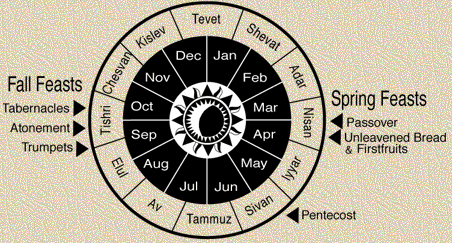 In our study, we also need to understand that Israel has two calendars: one,
their civil calendar, begins in the fall [Tishri, about September on our
calendar]; the other, their religious calendar, begins in the spring [Nisan,
about April on our calendar]. Religious and civil dating systems were based on
both lunar and solar cycles. In the calendar used by Jews today, a day is
counted from sunset to sunset, a week comprises 7 days, a month has 29 or 30
days, and a year has 12 lunar months plus approximately 11 days. In order to
bring the calendar in line with the annual solar cycle, a 13th month of 30 days
is added in the 3rd, 6th, 8th, 11th 14th, 17th, and 19th years of a 19-year
cycle. Therefore, a leap year may have from 383 to 385 days. The Jewish Era in
use today was accepted around the 9th century AD and is based on Biblical
calculations placing the creation in 3761 BC.
In our study, we also need to understand that Israel has two calendars: one,
their civil calendar, begins in the fall [Tishri, about September on our
calendar]; the other, their religious calendar, begins in the spring [Nisan,
about April on our calendar]. Religious and civil dating systems were based on
both lunar and solar cycles. In the calendar used by Jews today, a day is
counted from sunset to sunset, a week comprises 7 days, a month has 29 or 30
days, and a year has 12 lunar months plus approximately 11 days. In order to
bring the calendar in line with the annual solar cycle, a 13th month of 30 days
is added in the 3rd, 6th, 8th, 11th 14th, 17th, and 19th years of a 19-year
cycle. Therefore, a leap year may have from 383 to 385 days. The Jewish Era in
use today was accepted around the 9th century AD and is based on Biblical
calculations placing the creation in 3761 BC.
As we now look at the seven feasts in Leviticus 23:4-44, we would point out that seven is God’s number for perfection, holiness, wholeness and completion. The first four feasts, Passover, Unleavened Bread, First Fruits, held in the spring, and the late spring or early summer Feast of Weeks or Shavuot, have to do with the first advent of Jesus the Messiah. The long interval between the fourth and fifth feasts [Pentecost & Trumpets], reveal truth of God’s dealings with mankind up to and including the present dispensation of the Church. The last three fall feasts, Trumpets, Atonement and Tabernacles, teach truths concerning a future dispensation and God’s future dealings with Israel.
The Passover Feast
 Let's now look at the Passover
Feast. We see the first feast which is Passover as we read in verse 5 of
Leviticus 23: "In the fourteenth day of the first month (Nisan)
at even is the LORD's Passover." Some Bible teachers consider
the Feasts of Passover and Unleavened Bread as one feast. That’s okay, however,
we can find clear distinctions of purpose in the Scripture’s teaching of these
two feasts. Consider the following quote from The Bible Knowledge Commentary
on the New Testament, pp. 258-259:
Let's now look at the Passover
Feast. We see the first feast which is Passover as we read in verse 5 of
Leviticus 23: "In the fourteenth day of the first month (Nisan)
at even is the LORD's Passover." Some Bible teachers consider
the Feasts of Passover and Unleavened Bread as one feast. That’s okay, however,
we can find clear distinctions of purpose in the Scripture’s teaching of these
two feasts. Consider the following quote from The Bible Knowledge Commentary
on the New Testament, pp. 258-259:
“The Synoptic Gospels speak of the meal Jesus ate with His disciples as the
Passover meal. But the Gospel of John indicates Jesus died on the Cross at the
exact time that lambs were slain in preparation for the nation’s Passover meals
(John 19:14). This can be explained by the fact that the Feast of Unleavened
Bread was a seven-day feast following the one-day Feast of the Passover, but
sometimes all eight days were called “the Passover” (Luke 2:41; 22:1, Acts
12:3-4), or the seven days were the “Passover Week” (John 19:14). A different
explanation is that Jews in the first century followed two calendars in
observing the Passover. According to this view Jesus and His disciples observed
one date, eating the Passover meal before His crucifixion, whereas most of the
nation, including the Pharisees, followed the other calendar in which the
Passover lambs were slain on the very day of Jesus’ death.”
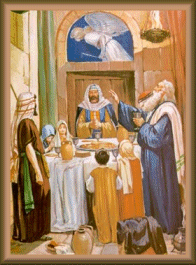 In the Feast of
Passover we find a picture or type of God’s plan of salvation for sinners. We
see its origin in Exodus 12:1-8 where we find that the Israelites who had been
in bondage for over 400 years were delivered by faith in the shed blood and
death of a lamb. On that Passover night, while the Israelites ate the lamb,
unleavened bread and bitter herbs, the death angel passed over the houses of the
believers who had obeyed God’s command to apply the blood of a literal lamb to
the lintel and doorposts of their houses. The Almighty God spared the lives of
Israel’s firstborn, but authorized the death angel to kill all the firstborn of
the Egyptians.
In the Feast of
Passover we find a picture or type of God’s plan of salvation for sinners. We
see its origin in Exodus 12:1-8 where we find that the Israelites who had been
in bondage for over 400 years were delivered by faith in the shed blood and
death of a lamb. On that Passover night, while the Israelites ate the lamb,
unleavened bread and bitter herbs, the death angel passed over the houses of the
believers who had obeyed God’s command to apply the blood of a literal lamb to
the lintel and doorposts of their houses. The Almighty God spared the lives of
Israel’s firstborn, but authorized the death angel to kill all the firstborn of
the Egyptians.
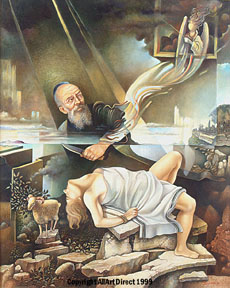
Sin and death are inseparably linked, for the Bible tells us “The wages of sin is death...” (Romans 6:23). Because of God’s unconditional covenant with Abraham, Isaac, and Jacob (Israel), He must provide deliverance of His people from the sentence of death and yet still remain perfectly holy and righteous. The way that God did this was through the sacrifice of the Passover lamb. The first direct reference to the lamb in Scripture is in Genesis 22:8 when Abraham said to Isaac: “God will provide Himself a lamb.”
The Passover lamb had to be selected (Exodus 12:3). This lamb pointed
to the person of Jesus Christ. Jesus Christ was selected by God to be the
sacrifice for the sins of the whole world. John the Baptist said of Jesus the
Messiah: “...Behold
the Lamb of God, which taketh away the sin of the world” (John 1:29).
The Passover lamb also had to be spotless. The Holy Spirit guided
the apostle Peter in using the same description of God’s Passover Lamb when he
wrote:
“Forasmuch as ye know that ye were not redeemed with corruptible things, as
silver and gold...But with the precious blood of Christ, as of a Lamb without
blemish and without spot” (1 Peter 1:18-19). Yeshua [Jesus] was God’s perfect
Lamb. He knew no sin, but was made to be sin for us that we might be declared
righteous in God’s sight. [See 2 Corinthians 5:21]. Jesus was God’s beloved Son in whom God
was "well-pleased" (Matthew 3:17). The lamb had to be kept up from the 10th to the
14th of the month to test it to make sure there was no blemish in it. Jesus’
life was also a period of testing. By His life, He showed that He was God’s
perfect Lamb and could be the substitutionary atonement for sinners. Even wicked
Pilate could find no fault in Him.
The Passover lamb had to be slain. The spotless life of our Lord Jesus Christ
was not enough to atone for our sin. He had to be slain. He had to shed His
blood and die for our sins. We are neither saved by the love of God nor by the life
of the Son of God, but by the blood of the Lamb of God. One day we will be able
to join in the angelic host around God’s throne to sing “Worthy is the Lamb
that was slain” (Revelation 5:12). Certainly, our blessed Redeemer, the Lamb of
God, Jesus the Messiah, is worthy of our total surrender and commitment to do
His will.
The Passover lamb had to be a substitute. The lamb had to die in
the place of the sinner. We see this in the very beginning of time when God had
to slay an animal to clothe Adam and Eve after their sin. Substitution is a
great doctrine in the Scriptures. We read Romans 5:8: “But God commendeth His love toward
us, in that, while we were yet sinners, Christ died for us.” Salvation is a
personal matter. When we repented of our sin and believed into the resurrected Lord Jesus
Christ and received Him as our one and only Redeemer, we were identifying with
our sin substitute.
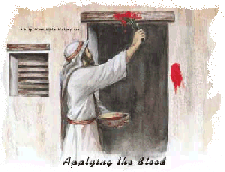 The blood
of the lamb also had to be applied. In both the Old and New Testaments, several
passages speak of sprinkling the blood. The lamb must be slain and the blood
shed, but it had to be applied personally by faith. When the
Hebrew children slew the lamb and applied the blood to the door posts and
lintel, they went through the door of their houses by faith and waited for God’s
deliverance. Jesus said in John 10:9: “I am the door: by Me if any man enter in, he shall be
saved...” Jesus, the spotless Lamb of God, has shed His precious
blood for the sins of the whole world. He has died for all, but His blood and
death are only sufficient for those who apply it by faith. The blood was the
Israelite’s protection, for God said: “When I see the blood I will pass over you.” When we,
by faith, apply the finished work of Jesus the Messiah through His shed blood
and death upon the Cross at Calvary to our hearts, we too have the assurance of
eternal salvation and security.
The blood
of the lamb also had to be applied. In both the Old and New Testaments, several
passages speak of sprinkling the blood. The lamb must be slain and the blood
shed, but it had to be applied personally by faith. When the
Hebrew children slew the lamb and applied the blood to the door posts and
lintel, they went through the door of their houses by faith and waited for God’s
deliverance. Jesus said in John 10:9: “I am the door: by Me if any man enter in, he shall be
saved...” Jesus, the spotless Lamb of God, has shed His precious
blood for the sins of the whole world. He has died for all, but His blood and
death are only sufficient for those who apply it by faith. The blood was the
Israelite’s protection, for God said: “When I see the blood I will pass over you.” When we,
by faith, apply the finished work of Jesus the Messiah through His shed blood
and death upon the Cross at Calvary to our hearts, we too have the assurance of
eternal salvation and security.
The Passover marked the new beginning on Israel’s calendar. God said in Exodus
12: 2:
“This month shall be the beginning of months to you.” When a believing
sinner can say in sincerity and truth, “Christ my Passover is sacrificed for me”
(1 Corinthians 5:7-8), he is born again. “Therefore if any man be in Christ, he is a
new creature...” (2 Corinthians 5:17). We have been bought by God, and the price was
the precious blood of the Lord Jesus the Messiah, the spotless Lamb of God. It
is from this Feast of Passover that we get our communion service. We can have
communion with God through the blood and bodily death of the Passover Lamb,
Yeshua the Messiah; and it is because of His bloody death upon the Cross and His
bodily resurrection three days later that we
too will be delivered from death to come and enjoy the presence of God for
eternity. We now have access to God's throne, the Holy of Holies, through the
finished work of Messiah Jesus as the Passover Lamb of God. As the songwriter N.
B. Herrell put it: "O, Behold the Man
of Sorrows, O, Behold Him in plain view. Lo, He is the mighty Conqueror, since
He rent the veil in two." AMEN!
2:
“This month shall be the beginning of months to you.” When a believing
sinner can say in sincerity and truth, “Christ my Passover is sacrificed for me”
(1 Corinthians 5:7-8), he is born again. “Therefore if any man be in Christ, he is a
new creature...” (2 Corinthians 5:17). We have been bought by God, and the price was
the precious blood of the Lord Jesus the Messiah, the spotless Lamb of God. It
is from this Feast of Passover that we get our communion service. We can have
communion with God through the blood and bodily death of the Passover Lamb,
Yeshua the Messiah; and it is because of His bloody death upon the Cross and His
bodily resurrection three days later that we
too will be delivered from death to come and enjoy the presence of God for
eternity. We now have access to God's throne, the Holy of Holies, through the
finished work of Messiah Jesus as the Passover Lamb of God. As the songwriter N.
B. Herrell put it: "O, Behold the Man
of Sorrows, O, Behold Him in plain view. Lo, He is the mighty Conqueror, since
He rent the veil in two." AMEN!
![]()
Passover Today
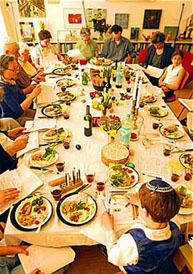 As we said earlier, Passover is the oldest of
all the Jewish holidays and marks the beginning of the religious calendar. The
Biblical background is found in Exodus chapters 12, 13 and 14. There is no real Passover today because there is
no Temple and no sacrificial system in Israel as of yet, though preparations are
being made for these things in the future. There was only one actual
Passover--only one occasion when the blood was applied to the door posts and the
lintels of believing homes--only once that the Lord went through Egypt to smite
the firstborn where the blood was not applied. So, according to Exodus 12:14,
every succeeding Passover was to be a memorial of that first Passover. Today,
the Passover Feast is a home service by the family, and Father or Papa is in charge. The family, and usually
the local synagogue, will hold a Seder service during Passover. The
Passover Seder has a theme of redemption and deliverance. Seder is the
Hebrew word for order. The service will follow a certain order as we shall see.
As we said earlier, Passover is the oldest of
all the Jewish holidays and marks the beginning of the religious calendar. The
Biblical background is found in Exodus chapters 12, 13 and 14. There is no real Passover today because there is
no Temple and no sacrificial system in Israel as of yet, though preparations are
being made for these things in the future. There was only one actual
Passover--only one occasion when the blood was applied to the door posts and the
lintels of believing homes--only once that the Lord went through Egypt to smite
the firstborn where the blood was not applied. So, according to Exodus 12:14,
every succeeding Passover was to be a memorial of that first Passover. Today,
the Passover Feast is a home service by the family, and Father or Papa is in charge. The family, and usually
the local synagogue, will hold a Seder service during Passover. The
Passover Seder has a theme of redemption and deliverance. Seder is the
Hebrew word for order. The service will follow a certain order as we shall see.
When Moses received the instructions from the Lord, he communicated them to the elders, who in turn communicated them to the heads of the families so that the whole congregation would know what God required to bring about their deliverance. Biblical instruction is a very vital part of a child's life. It is even more important than ever today as we see the truth of God's Word distorted and denied. Parents must know the meaning and significance of this important teaching of the Passover Feast to be able to present it to their children. Dad, do your children know what God requires for them to be truly saved and delivered from the wrath to come? Mom and Dad, do you set such an example before your children that they ask you to explain to them the meaning of following Christ? Parents have an important responsibility to lead their family in the ways of the Lord through instruction and by example.
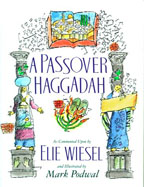
The two main parts of the service are (1) Seder--order of service which entails the eating of the meal and the order that will be followed; and (2) Haggadah--which is the story that goes along with the meal. The word Haggadah means "telling," and it is the recounting of the story of the Exodus of the Israelites from Egypt. The Haggadah is a script of what the leader and participants should say and the order of eating and drinking during each part of the meal as it tells the story of the Exodus from Egypt. The story of redemption that God provided for His people Israel is also the story of every Christian's redemption through God's grace by the death, burial and resurrection of the Messiah, the Lord Jesus.
 In preparation for Passover, the house
has to be purged of all leaven, which is a type of evil or sin. In many of the
Orthodox Jewish homes, Mama leaves ten little pieces of leaven around the house
purposely. They represent the ten sons of Haman who was going to destroy the
Jews. A search with a candle is conducted throughout the house. As the leaven is
found the father or grandfather will carry a wooden spoon and feather and will
sweep up the leaven into the spoon. The leaven is then put into a napkin, and
these items are taken outside and burned. The house has now been ceremonially
cleansed of leaven.
In preparation for Passover, the house
has to be purged of all leaven, which is a type of evil or sin. In many of the
Orthodox Jewish homes, Mama leaves ten little pieces of leaven around the house
purposely. They represent the ten sons of Haman who was going to destroy the
Jews. A search with a candle is conducted throughout the house. As the leaven is
found the father or grandfather will carry a wooden spoon and feather and will
sweep up the leaven into the spoon. The leaven is then put into a napkin, and
these items are taken outside and burned. The house has now been ceremonially
cleansed of leaven.
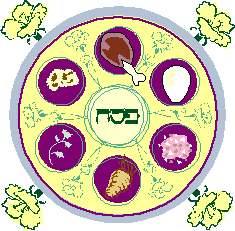
On the table is a ceremonial plate with certain items on it. Originally, there were only three items on the table -- (1) the Passover lamb, (2) the bitter herbs, and (3) the unleavened bread. After the destruction of the Temple in 70 AD, some other items were added for symbolism.
First we will mention the shank bone of the lamb. Rabbis say this is a picture of the Passover sacrifice. The shank bone is dry and tasteless and does not satisfy the physical appetite; just as Judaism without their Messiah brings no satisfaction to the spiritual appetite and is lifeless. Religion without Christ brings no peace and satisfaction to the sin-sick soul. There has been no acceptable sacrifice since Messiah's death on the Cross of Calvary. Jesus the Messiah was the last Passover Lamb accepted by God. He was the Supreme Sacrifice who died once for all, and God the Father showed His approval by the resurrection of His only begotten Son from the grave three days later. Jesus the Messiah, as the Lamb of God, is our sin-substitute. If you are saved today, it is because you have identified with Christ, the spotless Lamb of God, as your own personal sin-substitute. Blood has to be shed for the remission of sins. Good deeds [mitzvahs] are no substitute for the blood sacrifice. Even the average non-Jew thinks he or she can get to Heaven by doing good things. The only deliverance from the bondage of sin is through the blood of the Lamb of God.
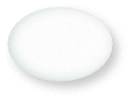 Also on the plate we find a
roasted egg. Some believe this is a good picture of the la
Also on the plate we find a
roasted egg. Some believe this is a good picture of the la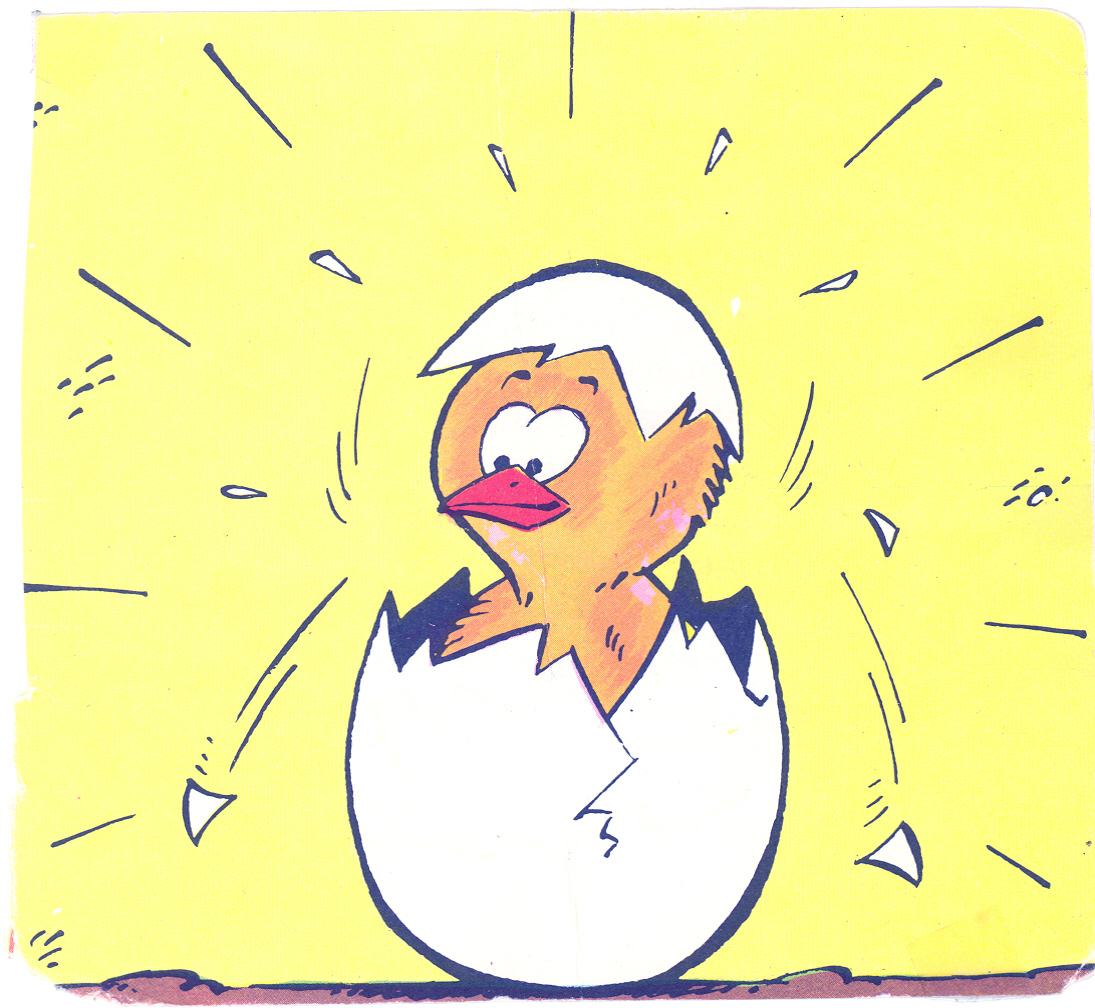 mb that had to
be "roasted whole" with not a bone broken (Exodus 12:46). Some rabbis tell us it is a
picture of the hardened heart of Pharaoh who refused to let God's chosen people
go until God smote Egypt with the death of the firstborn. Some say it is a
symbol of life and freedom. It's like the shell of the egg cracking and the baby
chick coming out to run free, just as the Hebrews were set free from bondage to
go to their Promised Land. Still other rabbis point out that it is to remind
them of the "voluntary peace offering" that was to be given on the second day of
Passover.
mb that had to
be "roasted whole" with not a bone broken (Exodus 12:46). Some rabbis tell us it is a
picture of the hardened heart of Pharaoh who refused to let God's chosen people
go until God smote Egypt with the death of the firstborn. Some say it is a
symbol of life and freedom. It's like the shell of the egg cracking and the baby
chick coming out to run free, just as the Hebrews were set free from bondage to
go to their Promised Land. Still other rabbis point out that it is to remind
them of the "voluntary peace offering" that was to be given on the second day of
Passover.
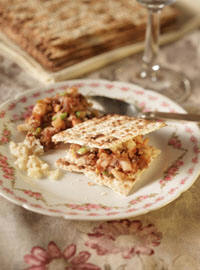 There is also a mixture of
apples, almonds, cinnamon, and the fruit of the vine on the plate. This mixture
is called charoset. It represents the mortar the
Israelites had to make to build the Egyptian cities. The apples represent the
sweetness of a better world. Out of the pressure of their bondage has come
sweetness and deliverance. The word Gethsemane means
"olive press." We are told in the Gospels that our Savior sweat great drops of
blood there as He contemplated going to the Cross and becoming sin for us. We
have been cursed by sin, but thank God, Jesus the Messiah has taken the curse
for us. He allowed that crown of thorns to be beaten down upon His head for us.
He allowed those spikes to be driven through His hands and feet for us. He
suffered the shame and disgrace and the forsaking of His heavenly Father for us.
Jesus became sin for us that we might be justified or declared righteous in
God's sight (2 Corinthians 5:21). Out of this pressure our Savior experienced at
Calvary has come the sweetness of the gift of eternal life and deliverance from
the bondage of sin.
There is also a mixture of
apples, almonds, cinnamon, and the fruit of the vine on the plate. This mixture
is called charoset. It represents the mortar the
Israelites had to make to build the Egyptian cities. The apples represent the
sweetness of a better world. Out of the pressure of their bondage has come
sweetness and deliverance. The word Gethsemane means
"olive press." We are told in the Gospels that our Savior sweat great drops of
blood there as He contemplated going to the Cross and becoming sin for us. We
have been cursed by sin, but thank God, Jesus the Messiah has taken the curse
for us. He allowed that crown of thorns to be beaten down upon His head for us.
He allowed those spikes to be driven through His hands and feet for us. He
suffered the shame and disgrace and the forsaking of His heavenly Father for us.
Jesus became sin for us that we might be justified or declared righteous in
God's sight (2 Corinthians 5:21). Out of this pressure our Savior experienced at
Calvary has come the sweetness of the gift of eternal life and deliverance from
the bondage of sin.
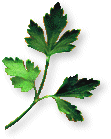
Another item we find on the ceremonial plate is karpas or fresh greens [usually parsley or celery]. This symbolizes the new life for the Jewish people and also represents the hyssop that was used to apply the blood of the Passover lamb to the lentil and doorposts. If the Jews had failed to apply the blood of the Passover lamb, then death would enter their homes. This involved a decision on the part of the people to be obedient to all that God had instructed. Jesus the Messiah has shed His blood for all. He tasted death for every person, but only when a person applies it personally by faith does it effectively cleanse sin. Salvation has always been by God's grace through faith. If I were the firstborn son, I would have made sure that dad applied plenty of blood so there would be no doubt when the death-angel passed over. God's Word, the Bible, clearly instructs us that repentance of sin and faith in Messiah's shed blood and resurrection are the only means of salvation. [See Acts 20:21].
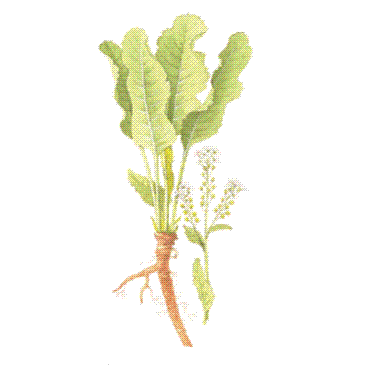
On the ceremonial plate we would also have some maror (bitter herbs). The bitter herbs, usually horseradish, speak of the bitterness the Israelites suffered as slaves in Egypt. It also reminds us of the bitterness of sin. Horseradish is not so bad when you first take a bite, but the more you chew it the more bitter it becomes. Sin is not so bad at first, but it becomes bitter, and we try to find a way to be delivered of it. The only way to be delivered from sin is to be washed in the blood of the Lamb of God. Only God can forgive and wash away our sins. We read in 1 John 1:9: "If we confess our sins, He is faithful and just to forgive us our sins, and to cleanse us from all unrighteousness." God can do this on the basis of what His only begotten Son did upon the Cross. It is "...the blood of Jesus Christ His Son that cleanseth us from all sin" (1 John 1:7).
There is a dish of saltwater available to those seated at the table. The saltwater speaks of the tears that were shed and of the sweat that came from the Israelites' years of slavery. It reminds them of the days of hardness. Think of all the tears that have been shed because of the bondage of sin. Sin pays its wages and is a hard taskmaster. The water also reminds them of the Red Sea that was parted for them as they left the land of Egypt and Pharaoh's army behind.

There are four cups, or rather, four times when the individuals at the table drink the fruit of the vine from the cup. Some reports indicate that possibly unfermented raisin-wine was the only acceptable beverage for Passover. Today only kosher wine or grape juice is used for Passover. These four cups are called:
(1) the cup of sanctification,
(2) the cup of rejoicing or thanksgiving,
(3) the cup of redemption, and
(4) the cup of communion or coming Kingdom.
These cups recall the four expressions of redemption mentioned in the Bible in Exodus 6:6-7. God tells Moses to tell the people of Israel: (1) "I will bring you out..." (2) "I will rid you out of bondage..." (3) "I will redeem you..." and (4) "I will take you to Me for a people..." This is a beautiful picture of what the Lord has done for us in redeeming us. By His blood, He has purchased us and brought us out of the slave market of sin, set us free from the bondage of sin, and taken us unto Himself by making us His child by faith.
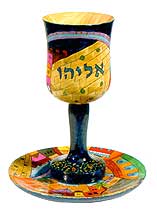 There is also a large cup on the table
called the Cup of Elijah. It is believed that on Passover night
that Elijah will come and announce the coming of the Messiah, hence a place is
set for him at the table.
There is also a large cup on the table
called the Cup of Elijah. It is believed that on Passover night
that Elijah will come and announce the coming of the Messiah, hence a place is
set for him at the table.
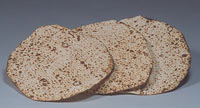
There is a plate or plates on the
table containing matzoth or unleavened bread. As we have already
mentioned, leaven in the Bible speaks of evil and sin. Having been
redeemed from Egypt, the Jewish nation was to put away "leaven" -- their former
manner of life -- and live a holy life unto the Lord. To the new nation God
said: "And ye shall be holy unto Me: for I the Lord am holy..."
(Leviticus
20:26). "For such [is Messiah Jesus] an high Priest...who is holy, harmless,
undefiled, separate from sinners, and made higher than the heavens"
(Hebrews
7:26). For those who have received the Lamb of God, the Scripture says that we
are to consider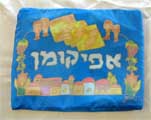 ourselves dead to sin, but alive unto God through Jesus Christ
our Lord. [See Romans chapter 6]. We are not to let sin reign in our body that we should obey it.
"Purge out therefore the old leaven, that ye may be a new lump,
as ye are unleavened. Therefore let us keep the feast, not with the old leaven,
neither with the leaven of malice and wickedness; but with the unleavened bread
of sincerity and truth" (1 Corinthians 5:7, 8). There is also
a matzah tosh, [Afikomen bag or unity bag], which contains
three pieces of matzah. Each piece of matzah is separated into its own
compartment inside of the bag. We will say more about that in a moment when we
discuss the service as it takes place in the home.
ourselves dead to sin, but alive unto God through Jesus Christ
our Lord. [See Romans chapter 6]. We are not to let sin reign in our body that we should obey it.
"Purge out therefore the old leaven, that ye may be a new lump,
as ye are unleavened. Therefore let us keep the feast, not with the old leaven,
neither with the leaven of malice and wickedness; but with the unleavened bread
of sincerity and truth" (1 Corinthians 5:7, 8). There is also
a matzah tosh, [Afikomen bag or unity bag], which contains
three pieces of matzah. Each piece of matzah is separated into its own
compartment inside of the bag. We will say more about that in a moment when we
discuss the service as it takes place in the home.
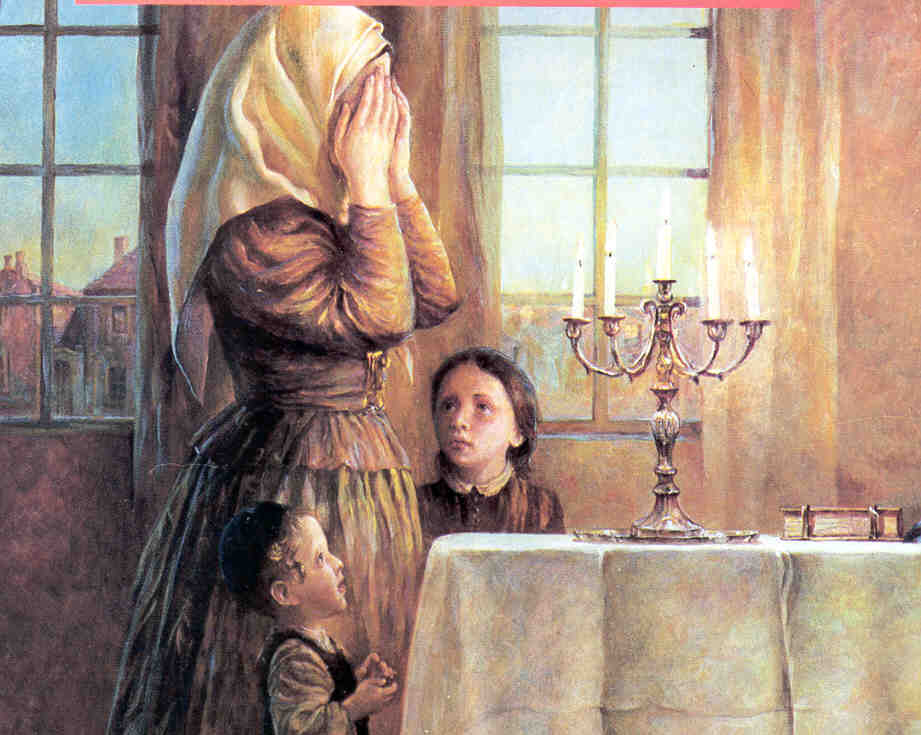
As the Passover Seder is ready to be observed in the Jewish home, Papa is usually seated and comfortable before anyone else is seated. To begin the service the lady of the house will kindle the candles and say a blessing thanking God, the King of the universe, for sanctifying them and allowing them to kindle the festival light. She thanks God for preserving them and enabling them to reach this season. Jewish women are taught that it was through a woman [Eve] that darkness came into the world since she was deceived by the serpent. Adam knew what he was doing when he went along with Eve and partook of the forbidden fruit. Thus, Jewish women light the candles for all of the Sabbaths and holy days and pray for the restoration of light to the world. We know that through Eve being deceived and Adam's willingness to go along with her brought sin and death into the world; but it was through another woman, the Virgin Mary, that God brought light into the world through His only begotten Son, the Lord Jesus the Messiah, God in the flesh. [See John 1:1-14].
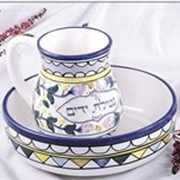
After the lighting of the candles and the blessing, the head of the house takes the first cup, the cup of sanctification, and gives thanks by saying the Kiddush or blessing. The Kiddush speaks about God's choosing Israel and setting them apart as His chosen people. Everyone than partakes of the first cup of juice which represents the first "I will" in Exodus 6: "I will bring you out." The host puts on the kitel (white coat) and kipah [head covering or yarmulkah] and there is the ceremonial washing of the hands [Urchatz] in the bowl of water. The kitel is worn on occasions of solemnity. It may be worn on a wedding day, or for burial, Yom Kippur and on Passover. It is a symbol of purity and freedom, and on Passover, freedom from human misery. It is white, because that is the color for royalty in Jewish tradition. It is the father who wears it since he is the initiator of the Passover -- the story of redemption.
The parsley or celery is now dipped into the salt water and passed around for all to partake. This is a picture of God parting the Red Sea so that Israel could enter the new land. As the wine or grape juice is red and represents the blood of the lamb, the greens also represent the hyssop which was used to place the blood upon the door posts and lintels.
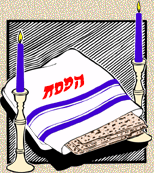 Next, the father takes the middle
matzah from the matzah tosh or unity bag, breaks it, wraps one half in a
napkin and sets it aside to be hidden away secretly during the meal, and the
other half is placed in the matzah dish. This piece of matzah is known as the
Afikomen, and we will say more about that in a moment. The father now holds up the matzah
bag and gives a blessing called the Maggid. The blessing says: "This is
the bread of affliction which our ancestors ate in the land of Egypt; let those
who are hungry, enter and eat thereof, and all who are in distress, come and
celebrate the Passover. Now we are here, but next year may we be in the land of
Israel..." This prayer is among the oldest in the Haggadah, from
before the destruction of the Temple.
Next, the father takes the middle
matzah from the matzah tosh or unity bag, breaks it, wraps one half in a
napkin and sets it aside to be hidden away secretly during the meal, and the
other half is placed in the matzah dish. This piece of matzah is known as the
Afikomen, and we will say more about that in a moment. The father now holds up the matzah
bag and gives a blessing called the Maggid. The blessing says: "This is
the bread of affliction which our ancestors ate in the land of Egypt; let those
who are hungry, enter and eat thereof, and all who are in distress, come and
celebrate the Passover. Now we are here, but next year may we be in the land of
Israel..." This prayer is among the oldest in the Haggadah, from
before the destruction of the Temple.
The second cup of juice is poured [but not drank at this time], and now begins the reciting of a form of thanksgiving called Haggadah. This will tell the story of Passover. There are four questions which are to be asked, usually by the youngest member of the family about why this night is different from other nights: (1) Why do we eat unleavened bread on this night? (2) Why do we eat bitter herbs on this night? (3) Why do we dip our vegetables twice on this night? (4) Why do we eat our meals reclining on this night?
The father goes on to answer the questions by telling how their forefathers were slaves in Egypt for 400 years. They eat unleavened bread because they left Egypt in a hurry. We eat bitter herbs to remind us of the bitterness of slavery. We dip twice because the karpas reminds us of the hyssop. Salt water represents the tears of the people. The bitter herbs with the charoset represent the bitterness of slavery being sweetened by the hope of freedom. We sit reclining this night because we have been set free and are no longer slaves.
There is also at this time a reciting of the ten plagues that God poured out on Egypt to bring about Israel's deliverance. As each plague is mentioned, each individual may dip a finger and drop ten drops [reciting a plague with each drop] onto a plate to show the "finger of God" in His judgment. It is also during this time that they may sing a song or chant Psalms 113 & 114.
The second cup, the cup of rejoicing or thanksgiving, is raised and the host recites a blessing extolling and blessing God for delivering their ancestors "from bondage to freedom, from sorrow to joy, from darkness to great light, and from servitude to redemption; and therefore let us sing unto Him a new song, Hallelujah!" This cup represents the second of four "I wills" in Exodus 6:6, 7: "I will rid you out of bondage..." Everyone raises their cups and recites the blessing: "Blessed art Thou, O Eternal, our King of the Universe, Creator of the fruit of the vine," and then they all partake the cup of rejoicing together. The host then ceremonially washes his hands again. This is the cup referred to in Luke 22:17: "And He took the cup and gave thanks and said, Take this and divide it among yourselves."
Now the matzah cakes are broken and served around the table, and a piece of the bitter herbs is dipped into the charoset and given to each person, which reminds them of the bitter bondage. Then all take two pieces of matzah and put some bitter herbs in between the two pieces in a sandwich-like fashion and dip it in the charoset. This comes from Exodus 12:8, which says they "with unleavened bread and with bitter herbs shall eat it." This is the sop which our Lord handed to Judas Iscariot during the Last Passover Supper, "who when he had received it, went out to betray the Lord" (John 13:30).
Next is the serving of the meal. There are several courses of good food and much rejoicing around the table. After the meal, the search is made for the Afikomen by the children. Among the Jewish people the Afikomen was a symbol for the Passover lamb, and they eat it in memory of that Passover lamb.

You remember the middle matzah of the three matzoth in the unity bag was broken; one piece was wrapped in a napkin and hidden away and only the father knows where it is. When held up to the light you can see that matzah is pierced and it has stripes. Isaiah 53 tells us: "...with His stripes we are healed." Zechariah 12 tells us: "They shall look on Him whom they have pierced." There is a great picture of the Trinity here, and the Jews do not realize it. The rabbis say that the three matzoth in the unity bag stand for Abraham, Isaac and Jacob, or for God, the high priest and the people. If they speak of Abraham, Isaac and Jacob, then the middle one speaks of Isaac the son of Abraham who was offered up as a sacrifice and is a picture of the Messiah. If it stands for God, the high priest and the people, then the middle piece represents the high priest who represents the people before God. Jesus the Messiah is our High Priest who represents us before God, and who has reconciled us to God.
What we have here is a beautiful picture of God the Father, God the Son, and God the Holy Spirit. The middle matzah is always broken and wrapped in a napkin and hidden away by the father. Our Lord's body was broken for us, wrapped in the burial cloths, and laid in a tomb, and only the Father knew where He was. Jesus said in John 6:35: "I am the bread of life..."
The Jewish people can't explain how this Greek word, Afikomen, got into their Hebrew service. Its Greek meaning can be understood as "that which is coming," like dessert; yet in one tense of the word it can mean "he who is coming." According to Jewish tradition, Messiah will come at Passover to bring a redemption like unto the redemption brought through Moses.
A generation before the Temple was destroyed, One who observed the feast in that upper room, "took bread, gave thanks and broke it, and gave it to them, saying, 'this is My body which is given for you; do this in remembrance of Me'" (Luke 22:19). The ultimate redemption did come at Passover. It wasn't a redemption from an earthly oppressor and an earthly bondage, but a spiritual deliverance from Satan, sin, and death. "If the Son sets you free, you will be free indeed" (John 8:36). We too can give thanks because we have been brought from the kingdom darkness into kingdom of the Son who is the light of the world.
When the child finds the Afikomen, he or she is rewarded--usually with money. When we discover the great truth of the resurrected Savior and believe upon Him, we are rewarded with eternal life. "...the gift of God is eternal life through Jesus Christ our Lord" (Romans 6:23). At the table the father holds up the broken Afikomen and invites all to partake. Christ, who has died for the whole world, invites whosoever will to come to Him and receive the gift of eternal life by repentance of sin and faith in His shed blood, death, burial, and resurrection.
A rabbi explained the Afikomen as follows: (1) It is special-not like any others. It is hidden away and then found. (2) It is brought out and displayed for everyone to see. (3) It is to be eaten during the meal. (4) Once you eat it, it is customary that you eat nothing else; it is the symbol of the Passover lamb, which was eaten last.
The Jews sing a song during Passover called "Dayenu." This Hebrew word means "it would have been enough." Part of the song says, "If He had taken us out of Egypt but had not punished them, Dayenu. He killed their firstborn...He split the Red Sea...He supplied our needs...He fed us the Manna...He brought us to Mount Sinai...He gave us the Torah...He brought us to the promised land..." and the refrain of "Dayenu, Dayenu, Dayenu--it would have been enough!" How wonderful that the sacrifice of the Lamb of God, Jesus the Messiah, is enough to save us from our sin and give us eternal life. It has power to cleanse us from all sin. Like the little girl who misquoted Psalm 23 when she said, "The Lord is my Shepherd, He's all I want." What a glorious truth in the Afikomen.
Now the third cup, the cup of redemption, is filled. This cup represents the third of four "I wills" in Exodus 6: "I will redeem you..." It is this cup after supper that Jesus raised and stated: "This cup is the new testament of My blood, which is shed for you" (Luke 22:20). Jesus' blood has redeemed us from our sins. The blessing of the cup is then said and everyone partakes of the third cup.
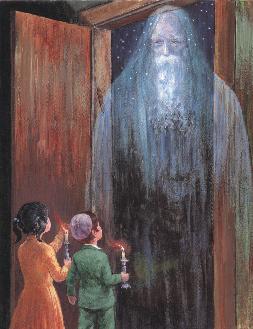
Now Elijah's cup is filled and a child is sent to the door to see if Elijah is there, because the Jewish tradition teaches that it is on Passover night that Elijah will come and announce the coming of the Messiah. The remainder of the Hallel Psalms (115-118) are sung. It is here that our Lord's farewell discourse took place. The father stands and announces that "all things are ready and they are waiting." After a few moments the door is closed.

Now the fourth cup is filled which is the cup of communion or coming Kingdom. It represents the fourth "I will" in Exodus 6: "I will take you to Me for a people." To Israel, this cup represents the hope of the Kingdom and Israel's glory restored. Our Lord told His disciples at the end of His last Passover meal: "Verily I say unto you, I will drink no more of the fruit of the vine, until that day that I drink it new in the kingdom of God" (Mark 14:25). The host now gives the final blessing on the fourth cup and all drink the cup together.
What a sad picture of the Jewish families who, year after year, have been opening the door of their homes in hope that Elijah will come to announce the coming of the Messiah. They may have their stomachs full, but if they don't know their Messiah by faith, their hearts are still empty. What they need to do is open their hearts' doors and let Messiah Jesus into their lives by faith. Thank the Lord many have done that.
Just as the candle is used to search the house for leaven, God's Word is the light that will expose the leaven of sin in our temple of the body where the Holy Spirit dwells. First Corinthians 5:6-8 teaches us to purge out the leaven in our lives and be a new unleavened lump for the Lord so that we can serve the Him in sincerity and in truth. It is very important for us to know what God's Word is saying to us about redemption from sin through believing in the atoning work of Messiah Jesus on the Cross of Calvary and applying it personally. It is only through that blood that we can be ransomed and set free from the bondage of sin.
If you are wandering from God today and lost in your sin, you can be brought into a right relationship with God [reconciliation] through the power of the cleansing blood of the Lamb of God, Jesus the Messiah. If you end up in the lake of fire, it will be because you chose to trample underfoot the Son of God and reckoned His blood as something unworthy (Hebrews 10:29). All of God's mercy, compassion and grace has its foundation in the blood.
There was a great deliverance and departure after the Passover. If you are not saved, you can come to Christ the Redeemer and Lamb of God today by faith and be delivered from the bondage of sin. You can depart from the old life of death and darkness and be on your way to the Promised Land--Heaven.
Christians, let us thank, extol and glorify our great and good God--Yahweh, that "Christ our Passover was sacrificed for us." This is the message that both Jew and Gentile need to hear, and may we be faithful in proclaiming it. Dayenu!
![]()
"God's Perfect Lamb"
by
Ron Hamilton
God spoke to Israel, "Bring Me a sacrifice,
Morning and evening, ev'ry day.
Offer a spotless lamb, without a blemish.
This is the command you must obey."
CHORUS:
Sing Hallelujah! Praise to Jehovah!
Worship the God of Abraham!
Sing Hallelujah! Praise to Jehovah!
Once for all is slain God's perfect Lamb!
Daily the lambs were brought. Daily the blood was shed,
Laid on the altar built by man.
Then at the perfect time, God said to Israel,
"I will now provide the perfect Lamb."
CHORUS:
Sing Hallelujah! Praise to Jehovah!
Worship the God of Abraham!
Sing Hallelujah! Praise to Jehovah!
Once for all is slain God's perfect Lamb!
At God's appointed time, Jesus, Messiah, came
To make the sacrifice for all sin.
No longer bring a lamb, Jesus has paid the price,
Clap your hands and let your psalms begin!
CHORUS:
Sing Hallelujah! Praise to Jehovah!
Worship the God of Abraham!
Sing Hallelujah! Praise to Jehovah!
Once for all is slain God's perfect Lamb!
©Copyright 1989
Majesty Music, Inc. All rights reserved.
Used with permission.
![]()